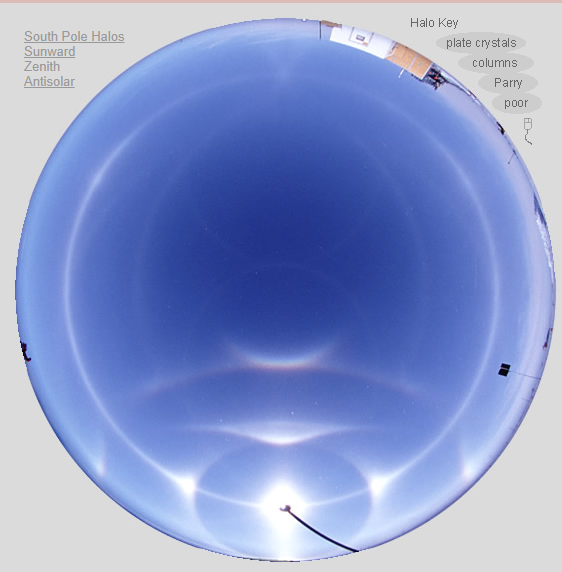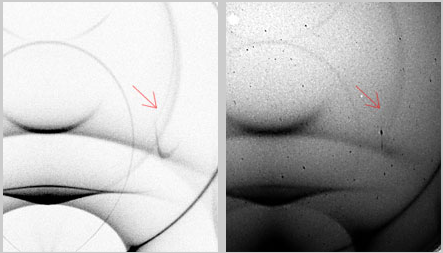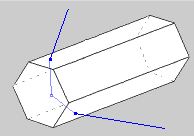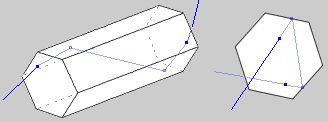South Pole Halos - Zenith View
South Pole Halos - Zenith View: Unveiling the Enigmatic Atmospheric Phenomena
Have you ever gazed up at the sky and marveled at the beauty and complexity of atmospheric optics? The South Pole, with its pristine and remote location, offers a unique vantage point for observing these captivating natural phenomena. On January 11th, 1999, Marko Riikonen captured an extraordinary all-sky view with his camera pointed directly at the zenith. This mesmerizing image reveals a myriad of halos and arcs that encircle the entire sky, providing a glimpse into the intricate interplay of light and ice crystals in the polar atmosphere.
Parhelic Circle: A Celestial Halo Encircling the Sky
The most striking feature of Riikonen's photograph is the complete ring of light known as the parhelic circle. This ethereal circle is formed by the interaction of sunlight with various types of ice crystals suspended in the atmosphere. Plate crystals, singly oriented columns, and Parry columns all contribute to the formation of the parhelic circle, creating a spectacle that encircles the observer.
-
Plate crystals, with their flat hexagonal shapes, produce 120° parhelia, which are bright spots of light located at a distance of approximately 120 degrees from the sun. These parhelia add a touch of radiance to the parhelic circle, enhancing its visual allure.
-
Singly oriented columns, on the other hand, give rise to a vibrant and colorful supralateral arc. This arc, which is relatively rare, manifests as a curving band of light above the horizon. In addition to the supralateral arc, singly oriented columns can generate other elusive halos that contribute to the intricate tapestry of atmospheric optics.
Unveiling Rare Halos: Wegener Arcs and Subhelic Arcs
Within Riikonen's photograph, we can discern a Wegener arc, which extends from the upper tangent arc to the anthelic point. This arc is formed by rays of light that follow similar paths to those responsible for the creation of the upper tangent arc. However, in the case of the Wegener arc, these rays undergo an additional internal reflection from a basal (end) face of the ice crystal. The Wegener arc adds a unique touch to the overall composition of halos, enhancing the visual complexity and captivating our imagination.
- Subhelic arcs, another rare phenomenon, can also be observed in Riikonen's image. These arcs curve upwards from the horizon and intersect with the Tricker arc above the anthelic point. Subhelic arcs result from the entrance and exit of light rays through prism end faces, with two intermediate internal reflections occurring within the crystal. The formation of subhelic arcs requires a high degree of crystal perfection, adding to their rarity and allure.
Distinguishing the Hastings Arc: A Delicate Art
Among the myriad of halos captured by Riikonen's lens, one stands out as particularly elusive—the Hastings arc. This arc, indicated by a red arrow in the enhanced image, is exceedingly rare and challenging to distinguish from its counterpart, the Wegener arc. Both arcs follow the same ray path, but the Hastings arc is formed by Parry crystals rather than singly oriented columns. The enhanced image, created through contrast enhancement and unsharp masking, allows us to glimpse the subtle intricacies of the Hastings arc, highlighting its ethereal beauty and mysterious nature.
The Unveiling of Atmospheric Optics: Aided by Technology
To gain a deeper understanding of these captivating atmospheric phenomena, scientists have turned to computer simulations. One such simulation, HaloSim, employs advanced algorithms to generate a realistic depiction of halos and arcs based on millions of light rays. By comparing these simulations to real-world observations, researchers can unravel the complexities of atmospheric optics and further our comprehension of the mesmerizing interplay between light and ice crystals.
Exploring the Wegener Arc: A Tangential Connection
The Wegener arc, tangential to the upper tangent arc, holds a special place in the pantheon of atmospheric optics. Rays of light entering a side face of a singly oriented column reflect off an end face before exiting through another side face inclined at 60 degrees to the first. This unique path results in the formation of the Wegener arc, which elegantly wraps around the circumscribed halo when the sun is at a high position in the sky. The Wegener arc adds a touch of mystique to the overall composition of halos, captivating our imagination and inspiring awe.
The Subhelic Arc: A Dance of Light Within Ice Crystals
Singly oriented columns and Parry columns collaborate to produce yet another remarkable atmospheric phenomenon—the subhelic arc. Rays of light entering an end face of the crystal undergo two internal reflections off side faces before exiting through the opposite end of the crystal. The net deviation, as viewed from the end of the crystal, is always 120 degrees, akin to the rays forming the 120-degree parhelia. The subhelic arc's graceful curvature and delicate interplay of light within ice crystals create a captivating spectacle that adds depth and intrigue to the intricate tapestry of atmospheric optics.
Conclusion: Unraveling the Mysteries of South Pole Halos
The South Pole provides a unique vantage point for observing atmospheric optics phenomena that are often elusive in other parts of the world. Marko Riikonen's photograph captures a mesmerizing array of halos and arcs encircling the zenith, offering a tantalizing glimpse into the intricate interplay between sunlight and ice crystals suspended in the polar atmosphere. Through careful observation and advanced simulations, scientists continue to unravel the mysteries of these captivating phenomena, expanding our knowledge of the natural world and inspiring us to gaze skyward with a renewed sense of wonder and curiosity.

South Pole 11th January 1999.
All sky view with the camera pointing to the zenith by Marko Riikonen.
The sky is completely ringed by a parhelic circle. Plate, singly oriented column and Parry column crystals all help light it.
Plate crystals form 120° parhelia.
Singly oriented columns produce a bright and colourful supralateral arc and even rarer halos. Mouse over the "Halo key" to identify them.
Touching the upper tangent arc and extending back to the anthelic point is a Wegener arc. Similar ray paths to those generating the tangent arc form it except that they are additionally internally reflected from an end (basal) face.
Other rare halos are subhelic arcs curving upwards from the horizon and touching the Tricker arc above the anthelic point. Subhelic arcs result from ray entrance and exit through prism end faces with two intermediate internal reflections. Crystal perfection is needed!.
Parry oriented columns form, among many others, the Hastings arc (of the upper suncave Parry arc). This has the same ray path as the Wegener arc (but from Parry crystals) and is very difficult to distinguish from it. The enhanced image below helps to show it.

Hastings arc
The right hand view is the display image in b/w negative form after contrast enhancement and unsharp masking. Negative images often show halos better. At left is a 30 million ray HaloSim simulation.
The exceedingly rare Hastings arc, red arrowed, is just visible. The heliac, antisolar and Wegener arcs show up strongly in the enhanced image.
Another view

Wegener arc
Formed by singly oriented columns. Similar ray paths to upper tangent arc (to which it is itself tangential) except that there is an internal reflection from a prism end face. Rays enter a side face, reflect off an end face and then leave through another side face inclined at 60º to the first. The arc wraps around the circumscribed halo at high sun.

Subhelic arc
Formed by singly oriented and Parry columns. Rays enter an end face, internally reflect off two side faces and leave the opposite end of the crystal. The net deviation as viewed from the end of the crystal is always 120º like rays forming the 120º parhelia.
Note: this article has been automatically converted from the old site and may not appear as intended. You can find the original article here.
Reference Atmospheric Optics
If you use any of the definitions, information, or data presented on Atmospheric Optics, please copy the link or reference below to properly credit us as the reference source. Thank you!
-
<a href="https://atoptics.co.uk/blog/south-pole-halos-zenith-view/">South Pole Halos - Zenith View</a>
-
"South Pole Halos - Zenith View". Atmospheric Optics. Accessed on April 27, 2024. https://atoptics.co.uk/blog/south-pole-halos-zenith-view/.
-
"South Pole Halos - Zenith View". Atmospheric Optics, https://atoptics.co.uk/blog/south-pole-halos-zenith-view/. Accessed 27 April, 2024
-
South Pole Halos - Zenith View. Atmospheric Optics. Retrieved from https://atoptics.co.uk/blog/south-pole-halos-zenith-view/.